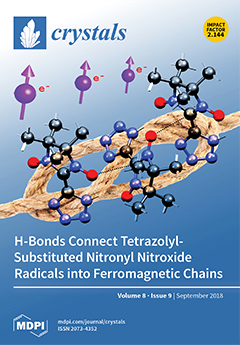Two new three-dimensional (3D) coordination compounds, namely a lead(II) coordination polymer (CP) {[Pb
3(µ
5-cpta)(µ
6-cpta)(phen)
2]·2H
2O}
n (
1) and a zinc(II) metal-organic framework (MOF) {[Zn
2(µ
4-cpta)(µ-OH)(µ-4,4′-bipy)]·6H
2O}
n (
2
[...] Read more.
Two new three-dimensional (3D) coordination compounds, namely a lead(II) coordination polymer (CP) {[Pb
3(µ
5-cpta)(µ
6-cpta)(phen)
2]·2H
2O}
n (
1) and a zinc(II) metal-organic framework (MOF) {[Zn
2(µ
4-cpta)(µ-OH)(µ-4,4′-bipy)]·6H
2O}
n (
2), were hydrothermally assembled from 2-(5-carboxypyridin-2-yl)terephthalic acid (H
3cpta) as an unexplored principal building block and aromatic
N,
N-donors as crystallization mediators. Both products were isolated as air-stable microcrystalline solids and were fully characterized by IR spectroscopy, elemental and thermogravimetric analysis, and powder and single-crystal X-ray diffraction. Structural and topological features of CP
1 and MOF
2 were analyzed in detail, allowing to identify a topologically unique 4,5,5,6-connected net in
1 or a very rare 4,4-connected net with the
isx topology in
2. Thermal stability and solid-state luminescent behavior of
1 and
2 were also investigated. Apart from revealing a notable topological novelty, both compounds also represent the first structurally characterized Pb(II) and Zn(II) derivatives assembled from H
3cpta, thus opening up the application of this unexplored pyridine-tricarboxylate block in the design of new metal-organic architectures.
Full article





